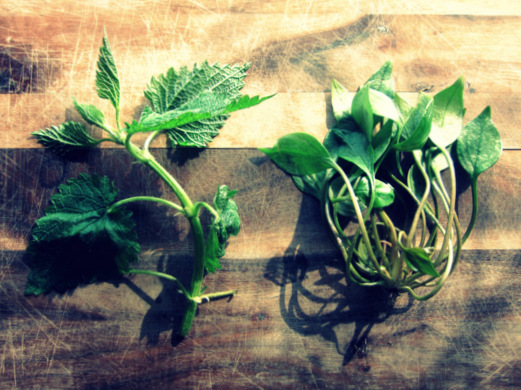Wild Greens

Note: This article is not meant as a substitute for proper medical advice. Please consult with your medical practitioner before using any type of remedy, herbal or otherwise.
By Robert Luby, MD
Mother Nature has a way of taking care of our nutritional needs year-round. After the winter root cellar is bare and before the summer vegetables abound, where can we turn to find fresh local foods brimming with vitamins, minerals, and fiber? After the citrus season has waned and before the summer fruits and berries burst onto the scene, where can we find fresh local sources of polyphenols, flavonoids, and antioxidants? The answer is greens: spring greens, bitter greens, and wild greens.
The last decade has witnessed a local trend in farming which aims to extend the growing season. Greenhouses and hoop houses shelter and nurture these nutrient dense foods so that they are available to the local consumer at a time when fresh local foods used to be difficult to come by. Wild foraging is another strategy to obtain tasty high density fresh foods during the spring time.
Local greenhouses provide us with some of our familiar staples such as spinach and arugula, but have you tried claytonia? Also known as purslane and miner’s lettuce, this early spring species is high in vitamin C and omega 3 fatty acids. It may be eaten raw and is a wonderful addition to salads and pesto. Wild leeks (ramps) and the closely related wild garlic species are other early spring favorites. These may be foraged locally in Vermont as well as being available for sale at City Market and local farmers’ markets. Like many greens, they are high in vitamins A and C. They have the additional distinction of being one of few foods to reliably contain high amounts of selenium and chromium.
Lamb’s quarters is a wild edible that is an earthy substitute for spinach. It is rich in vitamin C, B vitamins, iron, and many trace minerals. Sheep sorrel and wood sorrel provide a lemony flavor and may be eaten raw, cooked, or steeped in tea. Like spinach and some other greens, they contain high enough amounts of the “anti-nutrient” oxalic acid to merit the caution of consuming only in small quantities.
Some edible greens may be abundant in your own yard. Clover and chickweed are two such species. Clover leaves, like most greens, are best when eaten young, before the plant flowers. The leaves are best boiled or steamed, while the flowers are edible raw. Chickweed is most plentiful in spring, and may be used as an addition to salads. It is loaded with potassium, calcium, and iron.
Violets and dandelions are familiar sights in our yards, but these wild foods may also become familiar visitors to your plate. Both the leaves and flowers of violets may be eaten raw and add beauty and color to a salad. They are excellent sources of vitamins A and C. Dandelion greens have incredible culinary and nutritional diversity. They may be eaten raw, steamed, stir-fried, or added to soups. Nutritionally they contain B vitamins , vitamins C, D, and E, calcium, iron, magnesium, biotin, inositol, zinc, phosphorous, and beta-carotene.
A word of caution is in order about foraging for greens. Like all plants, edible greens “take up” whatever is in the soil. Therefore, be sure that if you forage, you harvest only from areas with healthy soil. Pesticides, herbicides, insecticides, and the like are also potential contaminants, so be sure to harvest only from areas where these are not used in the vicinity. Proper plant identification to avoid harmful or poisonous look-alike species is another essential of healthy foraging. Be sure to partner with an experienced forager or use a reliable plant identification guide.
It is more possible than ever before to include nutrient dense local greens into your spring diet. Visit the City Market produce department to try some of the varieties mentioned in this article. Happy foraging!